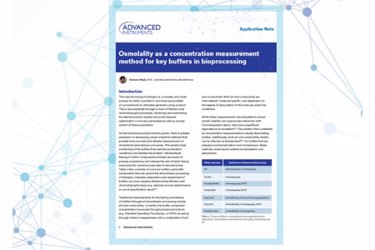Osmolality As A Concentration Measurement Method For Key Buffers In Bioprocessing
By Kristeena Wright, Ph.D., Linda Buck, Mark Hunter, Meredith Pesta

The manufacturing of biologics is a complex and costly process by which a protein is recovered and purified of contaminants to ultimately generate a drug product. This is accomplished through a chain of filtration and chromatography processes. Achieving and maintaining the desired product quality and purity requires optimization of process parameters as well as precise control of these parameters.
As the biopharmaceutical industry grows, there is greater emphasis on developing robust analytical methods that provide more accurate and reliable measurements to characterize downstream processes. This entails close monitoring of the buffers that maintain purification conditions and stabilize the protein1. Standardized testing of buffer components provides assurance of process consistency and reduces the risk of batch failure, improving the overall success rate of manufacturing. Table 1 lists a number of common buffers and buffer components that are used in the downstream processing of biologics. Improper preparation and assessment of buffers can have negative effects during filtration and chromatography steps (e.g. reduced process performance or out-of-specification result)2,3.
Traditional measurements for the testing and release of buffers throughout downstream processing include pH and conductivity. Currently, the buffer component concentration is ensured through procedural controls (e.g. Standard Operating Procedures, or SOPs) as well as through indirect measurement with a combination of pH and conductivity. Both pH and conductivity are inter-related4, molecule specific, and dependent on the degree of dissociation of the molecule under the conditions. While these measurements are invaluable to ensure protein stability and appropriate interaction with chromatography resins, they have a significant dependence on ionization5,6. This renders them unreliable as concentration measurements in weakly dissociating buffers. Additionally, both pH and conductivity meters can be affected by temperature5,6. For buffers that are prepared and stored below room temperature, these methods could require additional calculations and precautions.
Osmolality has been evaluated in this study as an orthogonal measurement with the potential to add consistency and improved control strategy for bioprocesses. Osmolality is a measurement of the moles of solute per kg of water, and therefore is expected to be relatively unaffected by the type of molecule, the degree of ionization, or the pH. This study was conducted to understand how osmolality can serve as a concentration measurement and how it compares to pH and conductivity measurements.
Get unlimited access to:
Enter your credentials below to log in. Not yet a member of Bioprocess Online? Subscribe today.
